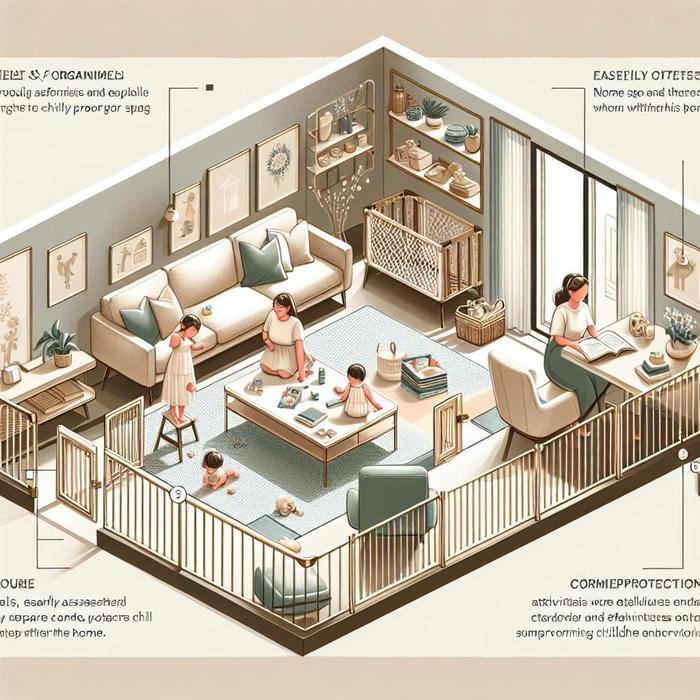Creating A Family-Friendly Environment: The Initial Steps
Emphasizing Suitable Spaces
When creating a family-friendly home environment, it’s crucial to prioritize spaces that are both engaging and safe for all family members- including the youngest ones. For a start, it’s essential to consider the perspectives of children in the design of your home. What appears safe and usable to an adult may not be child-friendly.
The living room, for instance, is often a central hub for family activities. It’s therefore imperative to ensure this space is geared towards accommodating the needs of all family members. For more detailed information on babyproofing your living room, check out our extensive guide.
Mastering the Art of Home Organization
While creating family-friendly spaces is a crucial part of a harmonious home, an equally essential element is organizing these spaces effectively. A well-organized home reduces stress, makes maintaining cleanliness easier, and aids in creating an overall peaceful environment. Visual appeal aside, a well-thought-out organization system is beneficial in fostering a sense of accessibility and usage among all family members.
Home organization tips for a family-friendly environment include:
- Labeling: This makes it easy for even the little ones to know where everything belongs.
- Utilize storage space: Clever use of storage helps in reducing clutter, creating more space for family activities.
- Teaching responsibility: Encourage the kids to be part of the organization process. This teaches them responsibility and allows them to contribute positively to the family environment.
For more in-depth tips on organizing a family-friendly home, check out The Little Design Corner.
Childproofing: Creating a Safe Environment
Childproofing is a vital yet often overlooked aspect of creating a family-friendly home environment. It involves adapting home surroundings to ensure the safety of the children. This is particularly important for families with toddlers and young ones who are naturally curious and love to explore their environments.
From securing heavy furniture, locking cabinets, covering electric outlets, to managing potential choking hazards, childproofing helps prevent numerous home-related accidents. Consider checking out the guide on managing baby’s teething pain for more insights.
Furthermore, remember that every home and child is unique, hence, childproofing may look different for each household. It’s beneficial to assess your home environment and make the necessary adjustments that fit your family’s needs. For ideas on how to childproof your home, visit Architectural Digest.
Creating Harmony: Balancing Functionality and Aesthetics
The ultimate goal of creating a family-friendly home environment is achieving a harmonious space that balances functionality and aesthetics. We aim for a home that not only accommodates children’s needs but also caters to adult tastes and preferences. The key lies in finding the perfect blend of child-friendly and visually appealing elements. A beautifully organized space that is safe and accommodating for all family members plays a pivotal role in nurturing a harmonious family life.
More to Come…
We’ve explored the initial steps of creating a family-friendly home environment – focusing on suitable spaces, organization, childproofing, and harmony. However, there’s much more to learn and implement. Soon, we’ll delve into more details about specific rooms and furniture pieces, play spaces, outdoor areas, and much more.
Designing Suitable Spaces
Preserving the home’s style while ensuring its suitability for kids is a delicate balance to strike. One approach is integrating kid-friendly materials in your decor. Consider using washable textiles, easy-to-maintain surfaces, and durable furniture. For instance, opt for a couch with removable, washable slipcovers or a coffee table with round edges to reduce potential injuries.
To create spaces that kids can claim as their own, consider incorporating play areas within common spaces. This can be as simple as dedicating one corner of your living room to a kids’ play area — this allows them to be present and engaged while adults can supervise their activities. For more ideas on kid-friendly home designs, visit The DIY Playbook.
The Importance of Flexibility
A family-friendly home should be able to adapt and grow with the family’s changing needs. Remember, what works today may not be the solution tomorrow, therefore, flexibility is key. Consider investing in furniture that can serve multiple purposes or be easily rearranged. For instance, opt for open shelving units that can be used for storing toys today and as a display unit later.
Creating Outdoor Living Spaces
It’s also important not to overlook the potential benefits of an outdoor living area. If your property permits, establishing a backyard play area can provide countless hours of entertainment for your children. Aside from these play spaces, you can also consider safe gardening zones to get your kids introduced to nature, or a dining area for memorable alfresco family meals.
Standardizing Cleanliness and Health
Another crucial aspect in a family-friendly home is cleanliness. A clean home is not only aesthetically pleasing but is also critical for maintaining good health. Integrate a cleaning routine into your family’s schedule and involve your kids in age-appropriate cleaning tasks. A clean and healthy environment promotes a sense of well-being and order, making the home a much more enjoyable space for everyone.
Moreover, maintaining a healthy indoor environment involves regulating air quality in the home. Consider investing in organic and hypoallergenic materials wherever possible. Prioritize proper ventilation and consider bringing in house plants which can contribute to improving your home’s air quality.
Host-Friendly: Making Your Home Welcoming
Finally, a family-friendly home should also be guest-friendly. Infuse warmth by creating comfortable guest spaces and integrating designs that facilitate conversation and interaction. For more tips on how to make your home family and host-friendly, visit here.
Up Next…
Now, you have a better understanding of how to create a family-friendly environment that emphasizes suitable spaces, flexibility, outdoor areas, cleanliness, and hospitality. Yet, there’s so much more to explore and implement- from designing kid’s bedrooms, playroom organization, to carving out the perfect homework spot. Stay tuned as we delve deeper into these topics in the upcoming posts.
In the meantime, consider exploring this beautiful family-friendly home for inspiration and ideas.
